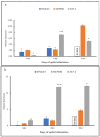SgR1, Encoding a Leucine-Rich Repeat Containing Receptor-like Protein, Is a Major Aphid (Schizaphis graminum) Resistance Gene in Sorghum
- PMID: 39795877
- PMCID: PMC11719657
- DOI: 10.3390/ijms26010019
SgR1, Encoding a Leucine-Rich Repeat Containing Receptor-like Protein, Is a Major Aphid (Schizaphis graminum) Resistance Gene in Sorghum
Abstract
Greenbug, Schizaphis graminum, is one of the important cereal aphid pests of sorghum in the United States and other parts of the world. Sorghum bicolor variety PI 607900 carries the Schizaphis graminum resistance (SgR1) gene that underlies plant resistance to greenbug biotype I (GBI). Now, the SgR1 has been determined as the major gene conferring greenbug resistance based on the strong association of its presence with the resistance phenotype in sorghum. In this study, we have successfully isolated the SgR1 gene using a map-based cloning approach, and subsequent molecular characterization revealed it encodes a leucine-rich repeat containing receptor-like protein (LRR-RLP). According to DNA sequence analysis, the SgR1 gene are conserved among GBI-resistance sorghum accessions but are variable within susceptible lines. Furthermore, an InDel (-965 nt) at its promoter region and a single-nucleotide polymorphism (SNP, 592 nt) in the CDS of the SgR1 were detected and they are well conserved within resistant genotypes. When the SgR1 gene was cloned and transferred into Arabidopsis plants, the SgR1 was activated in the transgenic Arabidopsis plants in response to attack by green peach aphids according to the results of the histochemical assay, and GUS activity was detected in situ in spots around the vasculature of the leaf where the phloem is located, suggesting its biological function in those transgenic Arabidopsis plants. Overall, this study confirms that the SgR1 gene coding for an LRR-RLP is the major resistance gene to greenbug, a destructive pest in sorghum and wheat. This represents the first greenbug resistance gene cloned so far and indicates that the simple-inherited GBI resistance gene can be used for sorghum improvement with genetic resistance to GBI via molecular breeding or cross-based conventional breeding technologies.
Keywords: LRR-RLP; aphid; gene cloning; host plant resistance; insect resistance; sorghum.
Conflict of interest statement
Authors declare no conflicts of interest.
Figures






Similar articles
-
[Inheritance of greenbug resistance in several forms of grain sorghum and sudangrass].Genetika. 2006 Jan;42(1):65-70. Genetika. 2006. PMID: 16523667 Russian.
-
Identification of a major quantitative trait locus conditioning resistance to greenbug biotype E in sorghum PI 550610 using simple sequence repeat markers.J Econ Entomol. 2007 Oct;100(5):1672-8. doi: 10.1603/0022-0493(2007)100[1672:ioamqt]2.0.co;2. J Econ Entomol. 2007. PMID: 17972647
-
Molecular mapping of QTLs for resistance to the greenbug Schizaphis graminum (Rondani) in Sorghum bicolor (Moench).Theor Appl Genet. 2008 Jun;117(1):117-24. doi: 10.1007/s00122-008-0757-8. Epub 2008 Apr 15. Theor Appl Genet. 2008. PMID: 18414829
-
Comparative transcriptomics of Diuraphis noxia and Schizaphis graminum fed wheat plants containing different aphid-resistance genes.PLoS One. 2020 May 22;15(5):e0233077. doi: 10.1371/journal.pone.0233077. eCollection 2020. PLoS One. 2020. PMID: 32442185 Free PMC article.
-
Sorghum aphid/greenbug: current research and control strategies to accelerate the breeding of aphid-resistant sorghum.Front Plant Sci. 2025 Jun 3;16:1588702. doi: 10.3389/fpls.2025.1588702. eCollection 2025. Front Plant Sci. 2025. PMID: 40530263 Free PMC article. Review.
Cited by
-
Biotype and host relatedness influence the composition of bacterial microbiomes in Schizaphis graminum aphids.Front Microbiol. 2025 Jul 30;16:1614492. doi: 10.3389/fmicb.2025.1614492. eCollection 2025. Front Microbiol. 2025. PMID: 40809050 Free PMC article.
References
-
- Harvey T.L., Hackerott H.L. Recognition of a Greenbug Biotype Injurious to Sorghum1. J. Econ. Entomol. 1969;62:776–779. doi: 10.1093/jee/62.4.776. - DOI
-
- Harvey T.L., Kofoid K.D., Martin T.J., Sloderbeck P.E. A New Greenbug Virulent to E-Biotype Resistant Sorghum. Crop Sci. 1991;31:1689–1691. doi: 10.2135/cropsci1991.0011183X003100060062x. - DOI
-
- Harvey T.L., Wilde G.E., Kofoid K.D., Bramel-Cox P.J. Temperature Effects on Resistance to Greenbug (Homoptera: Aphididae) Biotype I in Sorghum. J. Econ. Entomol. 1994;87:500–503. doi: 10.1093/jee/87.2.500. - DOI
-
- Eddleman B.R., Chang C.C., McCarl B.A. Economic Benefits from Grain Sorghum Variety Improvement in the United States. In: Wiseman B.R., Webster J.A., editors. Economic, Environmental, and Social Benefits of Resistance in Field Crops. Entomological Society of America; Annapolis, ML, USA: 1999. pp. 17–44. - DOI
MeSH terms
Substances
LinkOut - more resources
Full Text Sources
Research Materials
Miscellaneous

